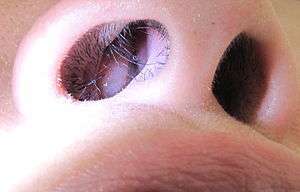Mouth breathing
| Mouth breathing | |
|---|---|
| Classification and external resources | |
| ICD-10 | R06.5 |
| ICD-9-CM | 784.9 |
| MeSH | D009058 |
Mouth breathing (also termed open-mouth breathing or a mouth breathing habit) is breathing through the mouth rather than the nose.[1]
Human infants are sometimes considered obligate nasal breathers, but generally speaking healthy humans may breathe through their nose, their mouth, or both. During rest, breathing through the nose is common for most individuals. Breathing through both nose and mouth during exercise is also normal, a behavioral adaptation to increase air intake and hence supply more oxygen to the muscles. Mouth breathing may be called abnormal when an individual breathes through the mouth even during rest. Some sources use the term "mouth breathing habit" but this incorrectly implies that the individual is fully capable of normal nasal breathing, and is breathing through their mouth out of preference. However, in about 85% of cases, mouth breathing represents an involuntary, subconscious adaptation to reduced patency of the nasal airway, and mouth breathing is a requirement simply in order to get enough air. Chronic mouth breathing in children may have implications on dental and facial growth. It also may cause gingivitis (inflamed gums) and halitosis (bad breath), especially upon waking if mouth breathing occurs during sleeping.
In the USA, the term "mouth-breather" is sometimes utilized as an insult, intended to imply low intelligence.[2]
Causes

Mouth breathing has been classified according to etiology into three groups: obstructive, habitual and anatomic.[3]:281
The nasal airway may be compromised partially (where there is increased resistance to the flow of air due to narrowing of the lumen at some point in the upper respiratory tract) or completely obstructed. Such individuals may find it difficult or impossible to breathe through their nose alone. In about 85% of cases, mouth breathing is an adaptation to nasal obstruction.[1] Specific causes of nasal obstruction which have been linked to mouth breathing include antrochoanal polyps.[4]:350
"Pregnancy rhinitis" may lead to nasal obstruction and mouth breathing. This tends to occur in the third trimester of pregnancy.[5]:435
Some individuals breathe through their mouth through force of habit, perhaps due to a previous cause of nasal obstruction that is now corrected.[3]:281
In other cases, the upper lip may be short, and the lips do not meet at rest ("lip incompetence").[3]:281
Potential effects
Gingivitis,[5]:85 gingival enlargement,[5]:85 and increased levels of dental plaque[5]:108 are common in persons who chronically breathe through their mouth. The usual effect on the gums is sharply confined to the anterior maxillary region, especially the incisors (the upper teeth at the front). The appearance is erythematous (red), edematous (swollen) and shiny. This region receives the greatest exposure to airflow during mouth breathing, and it is thought that the inflammation and irritation is related to surface dehydration, but in animal experimentation, repeated air drying of the gums did not create such an appearance.[5]:85
It has been suggested that chronic mouth breathing in children can lead to the development of a long, narrow face, sometimes termed "long face syndrome", or specifically "adenoid facies" when the mouth breathing is related to adenoid hypertrophy. Malocclusion of the teeth (e.g., "crowded teeth") is also suggested to result from chronic mouth breathing in children. Conversely, it has been suggested that a long thin face type, with corresponding thin nasopharyngeal airway, predisposes to nasal obstruction and mouthbreathing,[1] i.e., a long thin face may cause mouth breathing rather than the other way around. Facial form is also strongly influenced by genetic factors.
The following other conditions are also associated with mouth breathing: cheilitis glandularis,[4]:490 Down syndrome,[6]:365 anterior open bite,[5]:225 tongue thrusting habit,[5]:225 cerebral palsy,[7]:422 sleep apnea, and snoring.
References
- 1 2 3 Rao A, ed. (2012). Principles and Practice of Pedodontics. (3rd ed.). New Delhi: Jaypee Brothers Medical Pub. pp. 169, 170. ISBN 9789350258910.
- ↑ Dalzell T, Victor T, eds. (2008). The concise new Partridge dictionary of slang and unconventional English (8th ed.). London: Routledge. p. 443. ISBN 9780203962114.
- 1 2 3 Phulari BS, ed. (2011). Orthodontics : principles and practice. New Delhi: Jaypee Bros. Medical Publishers. ISBN 9789350252420.
- 1 2 Barnes L, ed. (2009). Surgical pathology of the head and neck (3rd ed.). New York: Informa healthcare. ISBN 9781420091632.
- 1 2 3 4 5 6 7 Newman MG, Takei HH, Klokkevold PR, Carranza FA, eds. (2012). Carranza's clinical periodontology (11th ed.). St. Louis, Mo.: Elsevier/Saunders. ISBN 978-1-4377-0416-7.
- ↑ Regezi JA, Sciubba JJ, Jordan RK (2011). Oral pathology : clinical pathologic correlations (6th ed.). St. Louis, Mo.: Elsevier/Saunders. ISBN 978-1455702626.
- ↑ Cawson RA, Odell EW (2008). Cawson's essentials of oral pathology and oral medicine (8th ed.). Edinburgh: Churchill Livingstone. ISBN 9780702040016.